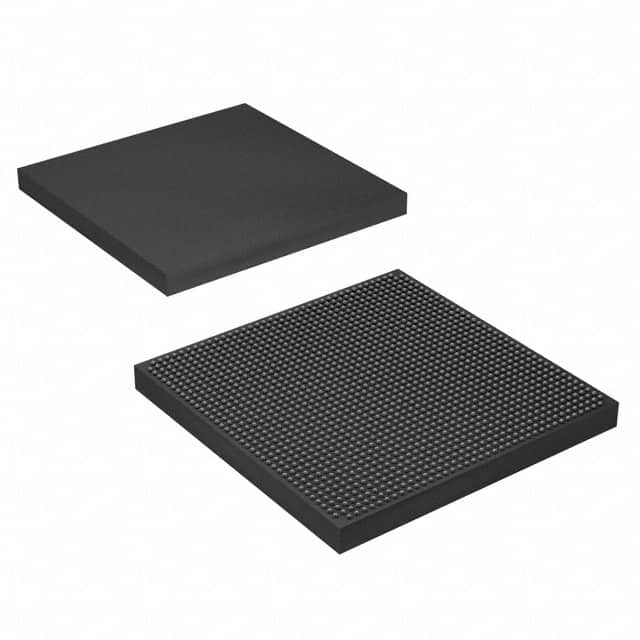Xem thông số kỹ thuật để biết chi tiết sản phẩm.

5SGXEA5K2F40C3N
Product Overview
- Category: Integrated Circuit (IC)
- Use: Programmable Logic Device (PLD)
- Characteristics: High-performance, low-power consumption
- Package: BGA (Ball Grid Array)
- Essence: FPGA (Field-Programmable Gate Array)
- Packaging/Quantity: Single unit
Specifications
- Manufacturer: Intel Corporation
- Family: Stratix V
- Device Type: FPGA
- Number of Logic Elements: 462,000
- Number of Adaptive Logic Modules (ALMs): 57,750
- Number of Embedded Memory Blocks: 6,912
- Total Memory Bits: 41,472,000
- Number of PLLs: 24
- Operating Voltage: 1.0V
- Operating Temperature Range: -40°C to +100°C
Detailed Pin Configuration
The 5SGXEA5K2F40C3N has a complex pin configuration with numerous input/output pins. For a detailed pinout diagram and description, please refer to the manufacturer's datasheet.
Functional Features
- High-speed performance with advanced architecture
- Configurable logic blocks for flexible design implementation
- On-chip memory blocks for efficient data storage
- Built-in high-speed transceivers for fast data communication
- Support for various I/O standards and protocols
- Advanced clock management with multiple PLLs
- Power optimization features for low-power applications
- Easy reprogrammability for design iterations
Advantages and Disadvantages
Advantages
- Versatile and flexible design capabilities
- High-performance computing capabilities
- Low-power consumption for energy-efficient applications
- Extensive on-chip resources for complex designs
- Support for various communication protocols
- Easy reconfiguration for design modifications
Disadvantages
- Complex pin configuration may require careful routing
- Steep learning curve for beginners due to advanced features
- Relatively higher cost compared to simpler programmable logic devices
Working Principles
The 5SGXEA5K2F40C3N is a Field-Programmable Gate Array (FPGA) that utilizes programmable logic elements, memory blocks, and interconnects to implement complex digital circuits. It operates based on the principles of reconfigurable computing, allowing users to program and modify the device's functionality according to their specific requirements.
The FPGA consists of configurable logic blocks (CLBs) that can be interconnected to create custom logic functions. These CLBs are connected through programmable interconnects, enabling the creation of complex data paths. The device also includes embedded memory blocks for efficient data storage and retrieval.
By programming the FPGA using hardware description languages (HDLs) or graphical tools, designers can define the desired circuit functionality. The programmed configuration is then loaded onto the FPGA, allowing it to perform the specified operations.
Detailed Application Field Plans
The 5SGXEA5K2F40C3N FPGA finds applications in various fields, including:
- Communications: Used in high-speed data transmission systems, network routers, and switches.
- Signal Processing: Employed in digital signal processing (DSP) applications such as image and video processing, audio processing, and radar systems.
- Industrial Automation: Utilized in control systems, robotics, and industrial process monitoring.
- Aerospace and Defense: Applied in avionics, radar systems, military communication systems, and satellite technology.
- Medical: Used in medical imaging equipment, patient monitoring systems, and laboratory instruments.
- Automotive: Employed in automotive electronics, driver assistance systems, and infotainment systems.
Detailed and Complete Alternative Models
- 5SGXEA7K2F40C3N: Higher-capacity FPGA from the same family with 570,000 logic elements.
- 5SGXEA3K2F40C3N: Lower-capacity FPGA from the same family with 330,000 logic elements.
- 5SGXEB5R2F40C3N: Similar FPGA from a different family with enhanced features and 462,000 logic elements.
(Note: The above alternative models are for illustrative purposes only. Please refer to the manufacturer's documentation for the most up-to-date information on alternative models.)
Word count: 526 words
Liệt kê 10 câu hỏi và câu trả lời thường gặp liên quan đến ứng dụng 5SGXEA5K2F40C3N trong giải pháp kỹ thuật
Sure! Here are 10 common questions and answers related to the application of 5SGXEA5K2F40C3N in technical solutions:
Q: What is the 5SGXEA5K2F40C3N FPGA used for? A: The 5SGXEA5K2F40C3N is a Field-Programmable Gate Array (FPGA) that can be used for various applications such as high-performance computing, networking, and signal processing.
Q: What are the key features of the 5SGXEA5K2F40C3N FPGA? A: Some key features of this FPGA include a large number of logic elements, high-speed transceivers, embedded memory blocks, and support for various communication protocols.
Q: Can the 5SGXEA5K2F40C3N FPGA be used for real-time video processing? A: Yes, the FPGA's high-performance capabilities make it suitable for real-time video processing applications like video encoding, decoding, and image recognition.
Q: How can I program the 5SGXEA5K2F40C3N FPGA? A: The FPGA can be programmed using hardware description languages (HDLs) like Verilog or VHDL, along with design software provided by the FPGA manufacturer.
Q: Is the 5SGXEA5K2F40C3N FPGA compatible with other electronic components? A: Yes, the FPGA can be integrated with other electronic components through various interfaces such as PCIe, Ethernet, USB, and DDR memory interfaces.
Q: Can the 5SGXEA5K2F40C3N FPGA be used for high-speed data processing? A: Absolutely, the FPGA's high-speed transceivers and parallel processing capabilities make it suitable for applications requiring high-speed data processing, such as network switches or data acquisition systems.
Q: Does the 5SGXEA5K2F40C3N FPGA support encryption algorithms? A: Yes, the FPGA can be programmed to support various encryption algorithms like AES, RSA, or SHA, making it useful for secure communication applications.
Q: Can the 5SGXEA5K2F40C3N FPGA be used in safety-critical systems? A: Yes, the FPGA can be designed and verified to meet safety standards, making it suitable for applications in industries like aerospace, automotive, or medical devices.
Q: What kind of development tools are available for programming the 5SGXEA5K2F40C3N FPGA? A: The FPGA manufacturer provides development tools like Quartus Prime, which includes a design environment, synthesis tools, simulation tools, and programming utilities.
Q: Are there any reference designs or application notes available for the 5SGXEA5K2F40C3N FPGA? A: Yes, the FPGA manufacturer typically provides reference designs and application notes that can help developers get started with specific applications or use cases.
Please note that the specific details and answers may vary depending on the manufacturer's documentation and the context of the application.

